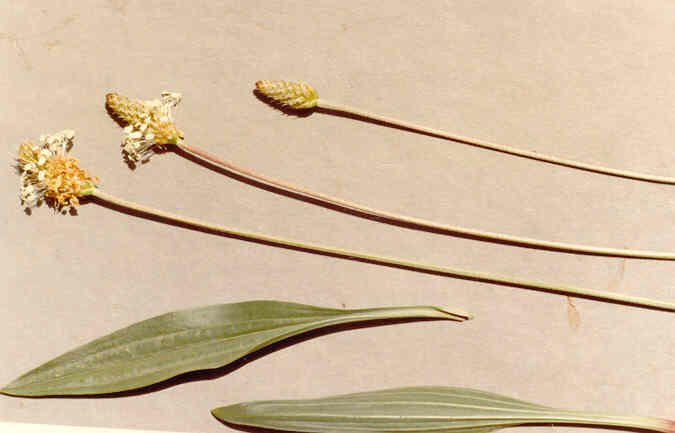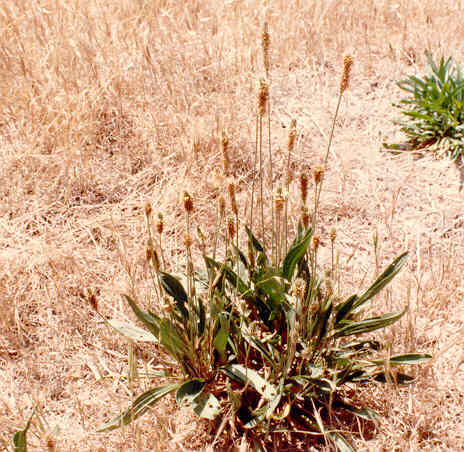
Plantago lanceolata L.
 |
Plantago lanceolata L.
Plantaginaceae (Plantain Family)EuropeEnglish PlantainRibgrass |
May Photo
Plant Characteristics:
Usually perennial with strong caudex, somewhat short-villous; lvs. lanceolate to
lance-oblong, erect or spreading, the blades 5-20 cm. long, attenuate at apex
and gradually narrowed into rather slender somewhat shorter petioles; scapes 2-8
dm. high, arched-ascending, rather slender; spikes dense, ovoid-conic at first,
cylindric and 2-8 cm. long in fr.; bracts broadly ovate, somewhat pubescent on
back, scarious-margined, ca. 2 mm. long; front sepals connate, ca. 3 mm. long;
corolla almost rotate, glabrous externally; stamens 4, anthers well exserted;
caps oblong-ovoid, dehiscing below middle; seeds 1-2, brown, shining, deeply
hollowed on one face, ca. 3 mm. long.
Habitat:
Weed in lawns and moist wet places.
April-Aug.
Name:
See P. erecta for generic name.
Latin, lanceolatus, lance-like.
(Jaeger 136). Probably
referring to the leaves.
General:
Occasional in the study area. Photographed
at 23rd Street. (my comments).
Supposed to be more tender than
P. major. Clarke makes
the following comments about P. major,
and they are presumably true also for P.
lanceolata. Young leaves are
today used as a potherb or in salads. They
become tough as they mature, but may still be cooked if chopped.
A handful of leaves can be steeped for a half-hour to make a cup of tea.
Seeds are often sought for caged bird food, parched or ground into meal,
or roasted. The whole seeds have a
laxative effect if eaten raw. (Clarke
205,206). Plantago species have been known to cause hay fever and asthma.
(Fuller 381).
The fresh leaves are a mild astringent and useful for cuts and scratches
and for dressing wounds when mashed to a pulp and applied.
The same is also highly recommended to give quick relief for external
rectal irritation of piles. (Meyer
97).
Text Ref:
Hickman, Ed. 821; Munz, Flora So.
Calif. 635; Roberts 32.
Photo Ref:
May 3 84 # 3,4.
Identity: by R. De Ruff, confirmed by F. Roberts.
Computer Ref: Plant Data 245.
Have plant specimen.
Last edit 3/23/03.
 |
May Photo